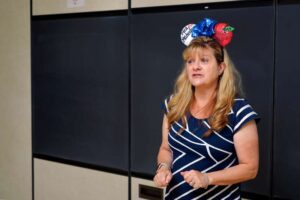by Susan C. Ingram, photography by Nikola Tzenov
School System Prepared to Support Students, Teachers & Parents Adapt
Last year, as elementary students returned to the classroom, teachers saw many children who were frustrated, lost and simply lacking the skills to learn in a classroom setting. It was a year spent understanding where kids were emotionally after the pandemic, learning how to reassure parents that their children would catch up emotionally and academically, and a year for teachers and administrators to themselves evolve with the changing needs in the classroom.
This year, while elementary school students, parents and teachers may still grapple with the residual effects of pandemic lockdowns, distance learning, and social isolation, Carroll County Public Schools administrators believe that the pieces are in place for elementary students to continue building on last year’s progress.
Steve Wernick, director of elementary schools for CCPS, noted that the entire 2021-2022 school year was full-day, in-person instruction, while some school systems were still relying on virtual and hybrid learning. That should make for a smoother 2022-2023 school year in Carroll County, he said, as elementary students have had time to readjust from the disruptions to the previous two school years.
“There were a lot of students, especially our primary students [pre-K to second grade], who may not have been in childcare or daycare settings because of COVID,” Wernick said. “So cooperation skills, the social skills, may not be as developed as we’ve seen in past years. They haven’t had those opportunities to go and play with kids at the park, or to go to their daycare setting, or even the grocery store. A lot of our students and families just couldn’t get out there because of COVID.”
Meanwhile, for intermediate elementary school students, grades three, four and five, Wernick said other skills were affected.
“We’re seeing more of the time-management, more of the perseverance piece, the team-player or group-building skills, because they were virtual and unable to connect, or work in a group,” he said.

A November 2021 article in Stateline, an initiative of the Pew Charitable Trusts, cited evidence that “violence and other behavioral challenges, including truancy, bullying, anxiety, depression and suicide risks, were up” in K-12 schools.
But Wernick said he’s not seeing bullying and aggression. “We’re seeing more of those executive functioning pieces lacking.”
For students experiencing anxiety, depression or other emotional upsets, Wernick said established programs focusing on social-emotional and mental health are effective.
“If a student’s feeling anxious, or upset, our teachers are those ‘first responders’ supporting those students,” he said.
For students dealing with these problems, the Second Step program offers social-emotional lessons that address students’ emotions and feelings and teach them to self-regulate and understand the feelings they’re experiencing. Another level of support is offered by school counselors, who visit classrooms regularly and meet with students individually, in small groups, or in informal settings such as “lunch bunches.” Elementary schools also have available a school psychologist, and a behavior specialist.
“If you have a child that’s experiencing behavior or some concerns, counselors can work with the family, they can work with the student, the teacher, to develop whatever’s needed,” Wernick said.
Students, and teachers, can also take “mental health days,” which are considered excused absences. There is also a county response team available, and a state-level mental health response team, although Wernick said he has not had cause to call them.
For students falling behind academically, unable to catch up with extra in-class support, or on their own time, CCPS implemented Quarantine Success Coaches and after-school and summer Extended Learning Opportunities in direct response to pandemic-related learning gaps.
“We also have reading and math intervention programs supporting students with gaps,” Wernick said.
“We’ve always had those programs, but we’re using them more.”
Regular emails and newsletters keep parents informed about available academic and mental-health programs as well as referrals to professional help in the community, if needed.
‘We build the plane in flight’
Twenty-seven-year veteran Spring Garden Elementary School teacher Erica McAndrew is known for her creative enthusiasm and her Mickey Mouse ears, which she wears in her first-grade class every day. She said flexibility, proactivity and collaboration are all necessary, any time, to help students and teachers perform at their best — and are especially important in meeting pandemic challenges.

“In all my teaching career, there’s never been a year that’s the same. The pandemic was a little bit bumpier along the way,” McAndrew said. “As teachers, we ‘build the plane in flight.’ We had to adjust to what the needs were for children and figure out what we needed to do to support them in the moment. Part of being a teacher is being super-flexible.”
McAndrew praised teachers, staff and administrators for their willingness to collaborate, and for supporting her “crazy ideas.” Some of those ideas included creative ways of using a school-wide behavior system that offers students rewards for good behaviors.
She used a stuffed ladybug, a leprechaun doll and a Mickey Mouse to reinforce and role-model good behaviors, including being kind and respectful, and sharing. To encourage students academically, McAndrew “adopted” a cow from the National Dairy Council and made ice cream in the classroom as part of a STEM (science, technology, engineering and math) lesson.
She credits the school system with being proactive and “hitting the ground running” with the Second Step program.
“It gave the kids the social situations, whether it was taking turns, or what to do if you’re feeling anxious, or what happens when somebody’s not being nice,” McAndrew said. “It really helped support our students.”
In addition, regular letters sent to parents supported them with at-home activities, which McAndrew called “a critical component.”
The pandemic also took a mental health toll on teachers like McAndrew, who — even though she earned the Teacher of the Year Award for 2022 — still sought out self-care activities, including a mind-body wellness class and integrating mindfulness, meditation and yoga into her day.
Regaining structure
Nicola Hildreth, CCPS’s supervisor of student services and school counseling, said the loss of structure, routines, social connection, and fostering of community in a classroom and within school “was a hardship for our students.”
“Students relearned or learned for the first time how to be a student in a school setting. They worked on their stamina for learning. They relearned how to follow directions in the classroom, in the lunchroom, at recess,” Hildreth added. “They learned how to ask for help, how to make friends, how to work through their feelings, how to be a student.”

Hildreth credits teachers for being patient with struggling students, meeting basic needs and creating safe learning spaces. But, Hildreth acknowledged, the system saw more students in need of learning support and help with coping skills.
“Students struggled with regulating their emotions, which could look one way for a student, crying, or another way for someone else, yelling,” she said. “We had students share suicide ideation and thoughts of self-harm.”
The National Association of School Counselors, in an article titled “Helping Children Cope With Changes Resulting From COVID-19,” encourages teachers and parents to stay vigilant about mental health. For preschoolers, adults should look for “thumb sucking, bedwetting, clinging to parents, sleep disturbances, loss of appetite, fear of the dark, regression in behavior, and withdrawal.” For elementary school children, “irritability, aggressiveness, clinginess, nightmares, school avoidance, poor concentration, and withdrawal from activities and friends” can signal it’s time to seek professional help, if these issues last more than two weeks.
Kristina Stacey, a guidance counselor at Carrolltowne Elementary School in Sykesville, also teaches future guidance counselors at McDaniel College in Westminster.
She noted that students made progress during the 2021-2022 school year, adjusting to the transition.
“At the beginning of the school year, I had many students who were hesitant to come into the building. I would have to, sometimes, guide them into the building. There was an increase of coming late to school,” she said. “We’ve seen kids who don’t want to leave their parents’ side. But it was much better [at year’s end].”
Stacey saw an increase in calls from parents requesting mental health days for students overwhelmed by getting back to life as it was pre-pandemic.
“When they were home there was always an adult around that fixed whatever was happening,” Stacey said. “Now, there’s one adult for 30 kids. I definitely see a huge increase of crying easily, becoming overwhelmed, because they can’t figure out how to problem-solve even little things.”
In teaching college students about counseling elementary-age students, Stacey offers tools to help students deal with anxiety on their own, including designating a “calm-down” space, and teaching breathing techniques that help students slow their breathing and calm anxious feelings.
Taking time to reconnect
Carole Williamson, early childhood education program director at Carroll Community College, said some of the best ways to help students, and teachers, readjust is for teachers and parents to reinforce routine and to listen, both of which can help students feel safer and reduce anxiety in an uncertain world.

“There is normalcy in routine that comforts us and provides a framework for our day,” Williamson said. “Often, when children have experienced a disruption in their routine, as they have during the pandemic, it may take time and patience to re-establish. But getting back to the routine will benefit the children and give them predictability that they might have been missing.”
Listening closely to students helps teachers and parents understand where a child’s anxiety is originating. Taking time during the day to reconnect with children gives them a safe space to talk about what might have frightened them.
“It is important to remember that angry children are often scared children,” Williamson said. “And their behavior may not be matching their emotion.”
In addition, unstructured play gives students unfettered, unscheduled time to unwind and let off steam.
“Children lost a lot of social-emotional learning during the pandemic. Teachers and parents might have to remind younger elementary children how to make friends, settle a dispute, or even to self-regulate. These are all best done through unstructured play,” Williamson said. “Play provides a safe space to act out their fears, practice their social-emotional skills, and use their imaginations in a productive way.”
In addition, Hildreth stresses that communication is vital during disrupted and stressful times. She recommends limiting time on devices and social media, putting parental controls on TVs, devices, and the internet. Concerning or harmful behavior may require a mental health professional to assess a student’s needs.
“Communicate with the student’s teacher, school counselor and if appropriate the school psychologist. We can do our best work when we work together,” she said.
‘Kids can soar’
At the end of the school year in June, McAndrew was already looking ahead to the 2022-2023 school year and excited about the possibilities.
“When we set our expectations that these kids are going to be successful, they’re going to make growth — they do,” she said. “I get really excited about seeing the progress and the growth that my students make, establishing rapport with families, and working with families to support students. Because working as a team really helps. When you have the support of your families, your kids can soar.”
More advice about helping children navigate the post-pandemic world, including the article “Helping Children Cope With Changes Resulting From COVID-19,” can be found at the website of the National Association of School Counselors (www.nasponline.org).













